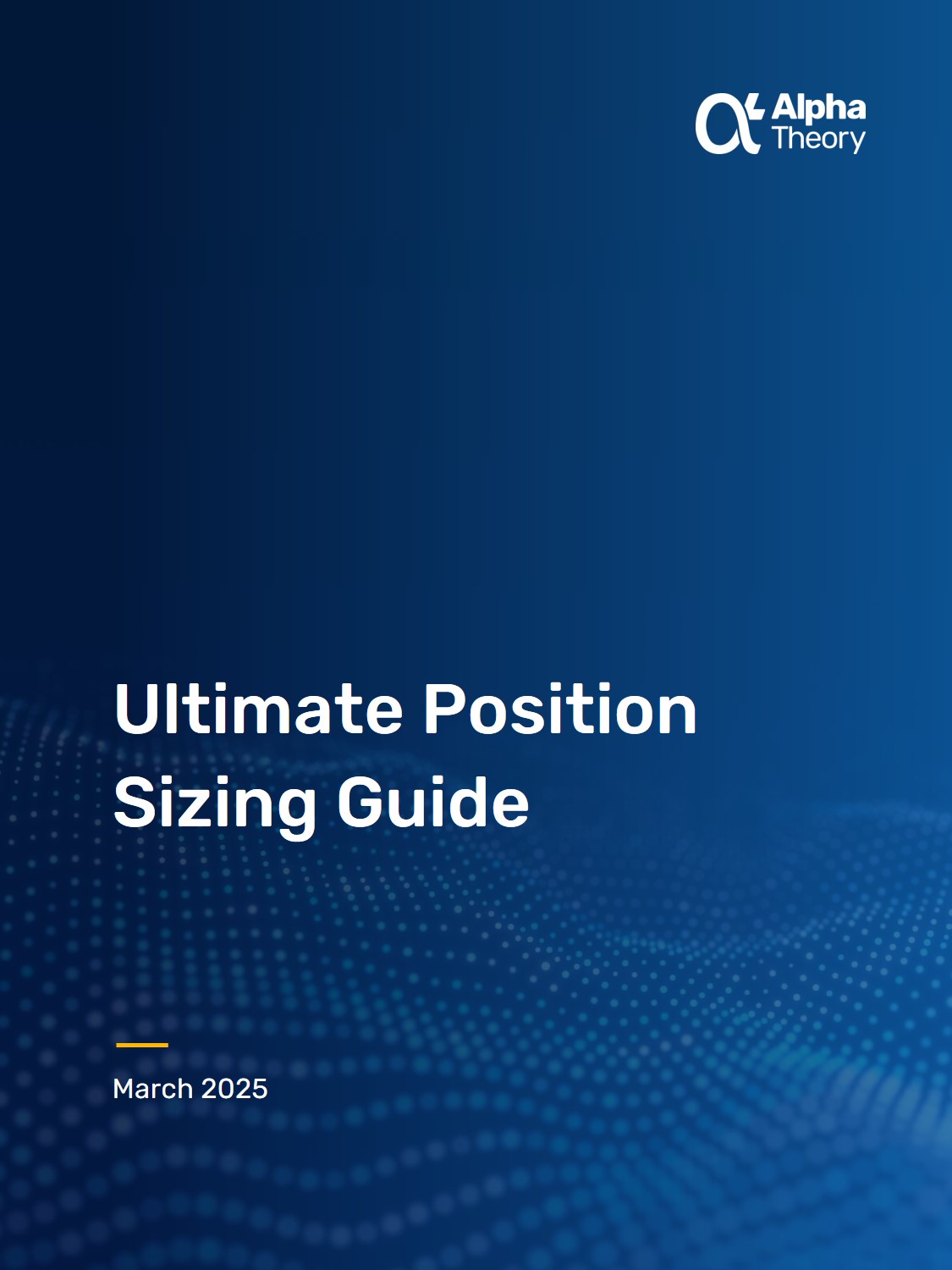What is Position Sizing?
An investor’s guide to the most critical, yet underrated, skill in investing
“It’s not whether you’re right or wrong that matters — it’s how much you make when you’re right and how much you lose when you’re wrong.”
– George Soros
If you manage money, you already feel this in your bones. What you own matters. But how much of it you own matters just as much.
Many investors have opined on this, yet few have a systematic process for optimizing it. Michael Mauboussin put it well, “Position sizing and portfolio construction still do not get the attention they warrant.” We agree. This guide to sizing is our attempt to change that. We will cover the basics, walk through a handful of examples, look at classic sizing models like Kelly, and finish with a modern process that fundamental managers can adopt without having to turn into full-on quants.
Let’s dive in.
Defining position sizing and why it drives results
Position sizing is the decision of how many dollars to put in each idea relative to other ideas in your portfolio. Investors commonly use a baseball analogy where stock picking is your batting average, and sizing is your slugging. Slugging is how much you make when you are right and how much you give back when you are wrong – this is exactly what George Soros meant.
If you want a better slugging percentage (better sizing), our decades plus worth of data suggests a structured process beats ad hoc. A structured process is based on a variety of explicit inputs such as price targets, probability of hitting those targets, conviction, and many other inputs that determine the position size. An ad hoc process is not based on a formula and relies on a manager’s mental math and intuition.
In our research across hundreds of historical portfolios, optimal sizing based on internally sourced inputs has outperformed actual client sizing most years, with an average spread of about four percentage points. Optimal sizing does not involve any magic or black-box technology – it simply means systematically using the information from your research to inform sizing decisions. This means that the raw ingredients funds need to optimize sizing and improve performance are already there; they are simply not utilized fully or applied systematically. We will touch on how managers can move toward optimal sizing later in this article, but first let’s look at a simple example.
A simple position sizing example you can picture
You have two names in your portfolio, both trading at $100.
- Stock A has a 50% chance to go to $140 and a 50% chance to drop to $80.
Expected price = 0.5 × $140 + 0.5 × $80 = $110. Expected return is 10%.
- Stock B has a 50% chance to go to $160 and a 50% chance to drop $80.
Expected price = 0.5 × $160 + 0.5 × $80 = $120. Expected return is 20%.
All else equal, you would size B larger than A. That is sizing in simplest terms. It just means aligning weight with expected return for each position. In the real world, things are not so simple, and there are other factors to consider – the degree of risk will be different for each name. Things like volatility, liquidity, drawdown risk, sector exposure, etc. add further complexity to the process of sizing.
Now add one more real-world wrinkle. Your expected returns get stale with time. If you update them rarely, your weights will drift away from what your latest data and research would suggest they should be. Our analysis has shown that when managers update price targets quarterly rather than semi-annually, the return on invested capital improves significantly by 3x. Move that update frequency to monthly and it improves further. Fresh inputs lead to better sizing decisions.
It’s not an easy task to keep all these moving pieces in your head at all times. These nuances and their real impact on performance suggest that a framework is needed to manage position weights and get the most out of sizing. But which framework is right for you?
Download the Ultimate Position Sizing Guide
A quick tour of classic position sizing frameworks
Equal weight and bands
Equal weight is just like what it sounds like. It is the simplest sizing framework and often performs better than most would guess because periodic rebalancing naturally takes profits from winners that are closer to target and adds to names that have lagged. This framework takes all judgement out of sizing and makes investing a binary exercise, you are either in or out of a name. Very few use this approach because they feel they can outperform an equal-weighted portfolio (and yes, many managers do). However, some managers use a modified equal weight model. They use weight bands, establishing lower and upper thresholds for certain categories like satellite, core, high conviction, and max conviction. Both are easy to run and easy to explain. The drawback is that they do not fully connect your sizing to your research edge, leaving the value of all your rich data on the table.
Pro: Simplicity
Con: Not practical in the real world of investing
Kelly Criterion
In 1956, John Kelly showed the optimal fraction to bet in a favorable game if payoffs are even. The formula for a simple coin with win probability p and loss probability q. The general formula is: f* = (p − q / b) where p is the probability of winning, q is the probability of losing (1 − p), and b is the odds or the net profit you stand to gain per unit wagered.
With a 60 percent coin and even odds (b = 1) , f* = 0.60 − 0.40/1 = 0.20. You would bet twenty percent of capital on each flip. This maximizes growth of capital in repeated trials. Ed Thorp took Kelly from blackjack to markets and popularized fractional Kelly for real life risk control. (Source)
Kelly is a powerful idea. It connects edge to size in a crisp way. It also has limits in real portfolios. Portfolio investments have many outcomes, not just two. It's a spectrum and time horizons matter as well. Portfolios hold many names at once, meaning they make bets simultaneously not sequentially which the optimal F requires. That is why most practitioners use Kelly as guidance, not as a sizing rule. If you think you have a small edge, size small. If your edge is large and stable, size larger. Then haircut it for real world risk.
A famous experiment showcased this concept. Victor Haghani and team gave people a favorable coin with a 60% chance of winning and a half an hour to place bets on coin flips. Everyone should be a winner but many went bust! The lesson was not about selection. It was about sizing and human behavior with all our emotions and biases. Process beat gut feel.
Pro: Connects edge directly to size
Con: Unrealistic for real-world portfolios with multiple simultaneous bets
Mean Variance Optimization
Harry Markowitz framed this classic tradeoff: maximize expected return for a target level of variance, or minimize variance for a target return. (Source: HKUST Math) Optimization works well for broad portfolios and index-like universes. But fundamental managers who run more concentrated books often want something transparent, with guardrails that reflect the way they actually underwrite names. They also want controls that help them “tweak” the inputs based on their perceived importance. They do not get this with MVO, which produces portfolios that are non-intuitive and “barbelled” with a few very large positions and many small positions with very little in the middle.
Pro: Mathematically elegant and useful for large, diversified portfolios.
Con: Opaque and impractical for concentrated fundamental portfolios — often produces extreme, barbelled results.
Download the Ultimate Position Sizing Guide
Fundamental Optimization: a modern position sizing process for fundamental managers
Ready to join the elite position sizers? Here is the playbook we use with managers who choose structure over gut-feel. We call it Fundamental Optimization.
- Define expected return the way you already think
Bull, base, and bear. Assign probabilities to each. Add analyst conviction. Liquidity and risk flags? Sure. Capture it all in one place so the team sees the same indicators.
- Translate research into optimal sizes
Use a rules engine that converts your inputs into proposed weights. Keep alerts on when actual weights drift from what your research implies. Revisit often. This is Fundamental Optimization in a nutshell.
- Measure the transmission
How much did you make from sizing decisions? Compare actual portfolio returns to an equal weight portfolio and then to an optimal portfolio built from your own targets. This isolates the slippage between research and weights. Over long time frames we have seen optimal outpace actual with a very high win rate.
If you want a deeper dive, Part 3 of our Ultimate Position Sizing Guide walks through best practices, team roles, and a step-by-step journey from basic target capture to a full feedback loop.
Pro: The optimal way to translate research into sizing
Con: Requires work and regular updates
What actually moves the needle for fundamental PMs
Three simple habits compound.
- Start with explicit expected returns. The fastest path is bull, base, and bear cases with attached probabilities. That gives every name a probability weighted target and a common language across the team.
- Keep the inputs fresh. Firms that update targets more frequently deliver better forward selection alpha. Our data shows a clear step up when you move from twice a year updates to quarterly and again to monthly.
- Transmit research into weights. Many teams do the analysis but lose alpha in the handoff from research to portfolio. Our work shows that a rules-based sizing process built on your own research outperforms with a very high win rate over time.
If you remember only one line, take Lee Ainslie’s:
"There are no holds. Either you would add at today’s price or you would put the capital somewhere better."
Make that your daily check.
Closing thought
The edge in fundamental investing is not just finding better ideas. It is expressing them with clarity and consistency. That means sizing with intent. Use simple math. Use fresh inputs. Use a process that transparently translates your research into weights and keeps you honest when emotions want to get in the way. Do that and the portfolio becomes a machine that reflects your best thinking every day. That is how active beats passive. That is how your best ideas become your best positions.
Sources and further reading about position sizing
- Ultimate Position Sizing Guide and related posts. Definitions, frameworks, and evidence that structure lifts returns.
- Cam’s Article on Freshness. Why quarterly and monthly updates move ROIC.
- Lack of Freshness Spoils Returns. Practical guidance on price targets and cadence.
- Position Sizing Quotes from the Greats. A curated set of investor quotes and our takeaways.
- Soros on outcomes. A reminder that magnitude beats hit rate.
- Lee Ainslie’s no holds mindset. A good rule for daily discipline.
- Kelly criterion. Original paper and Thorp’s application to markets.
- Haghani’s coin flip experiment. How unstructured sizing destroys edge.
- Markowitz mean variance. The foundation of optimization and why many PMs still want something more transparent.
Ready to join the elite position sizers now? Reach out to our team of experts and we will get you started in no time!

.svg)




.png)


